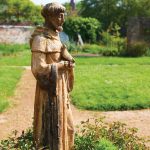Discover the history of the gardens and how we’re using the past to inform our future.
The garden itself has lived many lives, having been an estate for a wealthy Tudor family, a tea garden and a commercial plant nursery.
Today, we have an acre and a half of the original site in our care. It has been restored to evoke a taste of how the Franciscans would have seen it, complete with chapel, cloister garth and cutting garden.
The original Franciscan garden would have functioned both as a practical place to grow what was needed as well as a place of spiritual contemplation. A key part of a Friar’s training would have been a comprehensive understanding of plants and their different uses: for cooking, medicines, perfumes, dyes and construction.
Connecting with the changing seasons and marking the important religious festivals meant plants would have been used symbolically in the gardens and to decorate the altar of the once standing St Francis Chapel.

Other monastic communities settled on the outskirts of Canterbury would have been likely to support these humble ‘Greyfriars’ with additional food, beer and prayer, whilst the Franciscan monks concentrated on herbs, perfumes and medicinal plants to restore the sick and poor to health both physically and spiritually.
Explore the Gardens
The Friars’ Mediterranean roots would have been readily seen, with Olive trees, Myrtle and Hyssop. Fragrant Rosemary would have scented the air evoking Assisi, the Italian commune the Franciscans had originated from, and reminded them of the sacred purpose St Francis had set them on.
The garden would have been an unexpected paradise in the centre of Canterbury.
We honour this legacy today by running the garden on organic principles and choosing planting, like the wildflower meadow, which will benefit nature.


Greyfriars Chapel

Apple Orchard & Meadow

Meadow Border

Symbolic Love Garden

Cherry Walk

Cloister Garth

St Francis

Cutting Garden

Riverside Border

Victorian Vinery

Friars’ Path

Entrance Path
Illustration: Sarah Morgan FSGD
